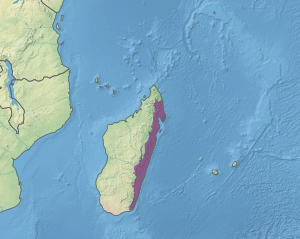Madagascar lowland forests
| Madagascar lowland forests | |
|---|---|

Humid forest in Masoala National Park
|
|
 |
|
| Ecology | |
| Realm | Afrotropic |
| Biome | Tropical and subtropical moist broadleaf forests |
| Borders | Madagascar subhumid forests, Madagascar spiny forests |
| Animals | Lemurs, chameleons, Mantella frogs |
| Geography | |
| Area | 112,100 km2 (43,300 sq mi) |
| Country | Madagascar |
| Elevation | 0–800 metres (0–2,625 ft) |
| Coordinates | 19°48′S 48°30′E / 19.800°S 48.500°ECoordinates: 19°48′S 48°30′E / 19.800°S 48.500°E |
| Geology | Metamorphic and igneous basement rock; locally lava and unconsolidated sands |
| Climate type | Tropical rainforest climate (Af) and Tropical monsoon climate (Am) |
| Conservation | |
| Conservation status | critical/endangered |
| Global 200 | included |
The Madagascar lowland forests or Madagascar humid forests are a tropical moist broadleaf forest ecoregion found on the eastern coast of the island of Madagascar, home to a plant and animal mix that is 80 to 90% endemic, with the forests of the eastern plain being a particularly important location of this endemism. They are included in the Global 200 list of outstanding ecoregions.
The ecoregion constitutes a narrow strip of lowland forests between Madagascar's east coast and the mountainous central highlands, from sea level to 800 metres (2,600 ft) elevation. It covers an area of approximately 112,600 square kilometres (43,500 sq mi). The ecoregion is under the direct influence of the oceanic trade winds, which maintain a warm, humid climate; rainfall is above 2,000 mm per year and can reach up to 6,000 mm on the Masoala peninsula.
The lowland forests extend from Marojejy in the north to the southeast corner of the island. At the northern edge of ecoregion around Vohemar, the moist forests transition to the drier Madagascar dry deciduous forests ecoregion. To the east, at approximately 800 metres (2,600 ft) elevation, the lowland forests transition gradually to the Madagascar subhumid forests ecoregion. The southern end of the ecoregion lies at the crest of the Anosyennes Mountains, where a narrow belt of dry transitional forest marks the transition to the dry spiny forests ecoregion in the mountains' rain shadow.
The lowland forests are characterized by dense evergreen forests, 82% of which is endemic species, with a canopy exceeding 30 metres (98 ft). Typical canopy species include Dalbergia, Diospyros, Ocotea, Symphonia, and Tambourissa; emergents of Canarium, Albizia, and Brochoneura acuminata rise above the canopy. The lowland forests have a rich diversity of Pandanus, palm, bamboo, and epiphytic orchid species. At higher elevations the trees become shorter and have a denser undergrowth.
...
Wikipedia
